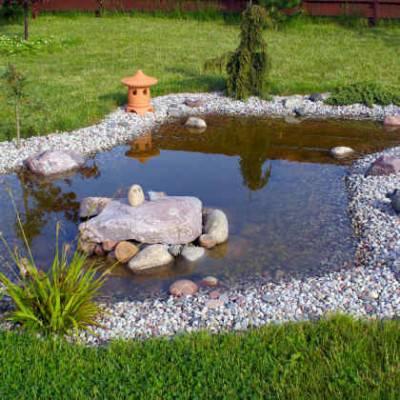Natural rainwater pond
A natural rainwater pond is a great solution for collecting rainwater. Rainwater is not always of the same quality and therefore not suitable for all fish. However, fish in the pond are important for keeping plants clean and mosquito control. You can take a number of measures to keep the water quality good.
Rainwater can be infiltrated into the riparian zone. Banks are an ideal environment for plants and animals in and around the water. Or you can discharge the water toward a pond. When discharging into the riparian zone, not all the nutrients get into the pond water. A disadvantage is that the pond is not always replenished with rainwater.
A natural rainwater pond is nice to look at and is good for flora and fauna. This pond is also easier to construct and maintain than an ordinary pond. Of course, you can also choose from different decorative elements and running water.
Cost
With a simple rainwater pond, the cost is usually limited. If you choose running water and lots of decorative elements, then this pond is obviously more expensive.
Space use
A plant pond with riparian zone requires a relatively large amount of space.
Difficulty
If you are a bit handy, it is easy to build a plant pond yourself. To avoid pond leaks, however, it is important to proceed carefully.
Earthmoving
A pond requires a lot of ground work. It is best to build the pond at the lowest point. Usually it means that you have to drain the soil what remains.
Maintenance

Like a regular pond, a rainwater pond also needs maintenance. In the rainwater pond, you put out fish that can handle the nutrient-rich and more acidic environment. In addition to the fish, the aquatic plants also need maintenance and the removal of debris from the pond. The plants in the riparian zone require less maintenance.
Climate Goals
The pond reduces heat stress and captures almost all the rainwater, relieving the sewer system and replenishing the groundwater in your garden. A pond with a variety of flowering plants is good for biodiversity.
Biodiversity
Contribution to improving biodiversity
Points of interest
- Place the pond in a lower part of your garden. Then when the bank and pond are full, you will still have plenty of room to collect the water.
- The pond and riparian zone should be large enough to accommodate substantial rainfall as well. If you have an overflow to the garden or street, 35 mm of the connected area is usually sufficient.
- Infiltrate as much rainwater as possible into the riparian zone. This will prevent the pond water from becoming too nutrient-rich and acidic.
- Put out strong fish in the pond; fish that can withstand rainwater, clean the plants and eat mosquito larvae.
- In old homes, the downspout is often also the vent to the dirty water sewer. If you disconnect this downspout then you must restore the venting.